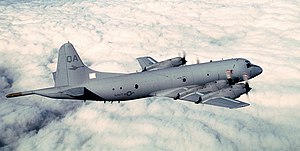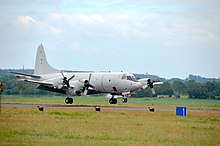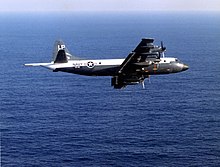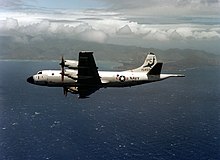Lockheed P-3
| Lockheed P-3 Orion | |
|---|---|
 Lockheed P-3C of the US Navy |
|
| Type: | Maritime reconnaissance and submarine fighter aircraft |
| Design country: | |
| Manufacturer: | |
| First flight: |
November 25, 1959 |
| Commissioning: |
1962 |
| Production time: |
1961 to 1990 |
| Number of pieces: |
757 |
The Lockheed P-3 Orion is a four-engine propeller-driven aircraft that is used worldwide as a maritime patrol aircraft and anti -submarine aircraft. The P-3 Orion is a military derivative of the civil aircraft Lockheed L-188 Electra (first flight December 6, 1957).
history
The first flight was on 25 November 1959. The Orion was founded in 1962 as a P-3 in the armed forces of the United States put into service. The original series were replaced in 1979 by the P-3C, the last of which was built in 1990. In the USA P-3 Orion were in their primary role 2010-2019 by the P-8 Poseidon from Boeing , a military version of the B-737-800 replaced. The last user was the VP 40 patrol squadron stationed on Naval Air Station Whidbey Island . Only one US Navy squadron stationed on Marine Corps Base Hawaii for special projects still uses the P-3C. The US meteorological authority National Oceanic and Atmospheric Administration (NOAA) also uses two P-3s in the WP-3D version, which have been specially equipped for recording and evaluating meteorological data. On April 1, 2001, an EP-3E Aries II, one had to SIGINT -Aufklärer the US Navy , on the island of Hainan in China make an emergency landing after a Chinese fighter plane type Shenyang J-8 had collided.
In addition, various P-3 variants are still in active service with a number of export customers.
crew



In the German Navy , the crew usually consists of eleven members. Crew members take turns at the arched lookouts. These are:
- Commander / Pilot (Aircraft Commander or Patrol Plane Commander, "PPC" for short)
- Copilot ("2P" for short)
- Flight Engineer ("FE" for short)
- On-board electronics technician (in-flight technician, "IFT" for short)
- Tactical Coordinator ("TACCO" for short)
- Navigator / transmission specialist ("NAV / COM" for short)
- 3 × surface operators
- 2 × underwater surgeons
In the US Navy, there is also a replacement pilot and the operators have more specific tasks (sensors 1–3).
variants
- YP-3A (YP3V-1): prototype
- P-3A (P3V-1): Anti-submarine aircraft, 157 built
- EP-3A: seven P-3A, the electronic intelligence were converted
- NP-3A: three P-3A converted into test aircraft
- RP-3A: two P-3A that have been converted for research purposes
- TP-3A: twelve P-3A without ASW equipment for pilot training
- UP-3A: 38 P-3A that have been converted into transport aircraft
- VP-3A: three WP-3A and two P-3A that have been converted into VIP aircraft
- WP-3A: four P-3A of the US Department of Commerce converted to weather reconnaissance
- P-3A Slick: six P-3A retrofitted for the US Customs Service with the radar of the F-15E
- P-3ACH: four P-3A retrofitted for Chile with the interior of the Boeing 727 with 65 seats
- P-3AM: nine P-3A extensively modified for the Força Aérea Brasileira (FAB) at Airbus Military
- P-3A Aerostar: six P-3A from Aero Union, converted as fire fighting aircraft
- P-3B: Anti-submarine aircraft, 144 built, had more powerful engines
- EP-3B: two P-3B modified for electronic reconnaissance
- P-3B Aerostar: a P-3B from the Aero Union company converted into a fire-fighting aircraft
- P-3BR: alternative name for the P-3AM for the nine P-3A modified by EADS for the FAB
- P-3CK: eight P-3B modified for South Korea
- P-3C: Anti-submarine aircraft, built from 1968 onwards, 267
- P-3C CUP: 13 Dutch P-3C Update II.5, which received a new data processing system, a new radar, a new acoustic processor, as well as new ESM equipment and SATCOM. Sold in 2006 after modifications to Germany (8) and Portugal (5).
- P-3C Update I: 31 P-3C with new avionics, which were built from January 1975
- P-3C Update II: 44 P-3C with infrared locating and sonar buoy reference system, built from August 1977
- P-3C Update II.5: 24 aircraft built in 1981; they received improved navigation and communication systems
- P-3C Update III: 50 P-3Cs built from May 1984; they received a new acoustic processor, sonar buoy receiver and an improved auxiliary power unit
- P-3C Update IV: Version with better systems for electronic measures, additional search radar and sensors for locating quieter submarines
- EP-3C: Japanese version of the Kawasaki P-3C for electronic reconnaissance
- NP-3C: a P-3C converted into a test aircraft
- RP-3C: P-3C modified to a research aircraft
- UP-3C: two Kawasaki converted transport aircraft
- RP-3D: a P-3C converted for atmospheric data acquisition
- WP-3D: two P-3A retrofitted for the National Oceanic and Atmospheric Administration for weather reconnaissance
- EP-3E: Aries: twelve machines for electronic reconnaissance
- EP-3E: Aries II: twelve P-3C with the equipment of the EP-3B
- NP-3E: test aircraft
- P-3F: six P-3C with in-flight refueling equipment for Iran
- P-3G: initially the name of a heavily modified P-3, renamed P-7A in 1989. The order for two prototypes and 123 series aircraft was canceled in 1990.
- P-3H: proposed replacement version for the deleted P-7A
- P-3K: Boeing-modified P-3B of the New Zealand Air Force
- P-3K2: P-3K (glass cockpit, new navigation system, new deployment and communication systems) modernized by L-3 with subcontracting to Safe Air ( Blenheim, NZ )
- P-3M: P-3B of the Spanish Air Force modified by EADS / CASA
- P-3N: two P-3B now in the Norwegian Air Force , which serve as search and rescue aircraft. Some of the anti-submarine equipment was removed.
- P-3P: six Portuguese Air Force P-3B that have been upgraded to P-3C Update II.
- P-3T: two P-3A modified for the Thai Navy
- VP-3T: a P-3A that has been modified to be a VIP transport aircraft for the Thai Navy
- P-3W: 20 P-3C-IIs of the Australian Air Force with Australian Barra sonar buoy system, modified to AP-3C, three P-3B were converted to TAP-3 for pilot training
- P-3AEW & C: US Customs early warning aircraft, air surveillance radar to combat drug smuggling. First flight June 14, 1984.
- CP-140 Aurora : 18 modified P-3Cs with the anti-submarine systems of the Lockheed S-3 for the Royal Canadian Air Force . Ten of them are to be modernized for 156 million dollars in the ALSEP (Aircraft Service Life Extension Program) for a further 20-25 years.
- CP-140A Arcturus : three Canadian machines with no anti-submarine fishing equipment
Users
The United States and Japan own a large portion of P-3C. (USA 161, Japan 110)
-
 Argentina (6 P-3B, 4 P-3C)
Argentina (6 P-3B, 4 P-3C) -
 Australia (16 AP-3C, ex 19, scrapping started in late 2014)
Australia (16 AP-3C, ex 19, scrapping started in late 2014) -
 Brazil (9 P-3AM or P-3BR)
Brazil (9 P-3AM or P-3BR) -
 Chile (4 P-3A)
Chile (4 P-3A) -
 Germany (8 P-3C)
Germany (8 P-3C) -
 Greece (6 P-3B)
Greece (6 P-3B) -
 Iran (5 P-3F)
Iran (5 P-3F) -
 Japan (101 P-3C, 5 EP-3E, NP-3E, 1 UP-3C; license production)
Japan (101 P-3C, 5 EP-3E, NP-3E, 1 UP-3C; license production) -
 Canada (CP-140 and 140A Aurora)
Canada (CP-140 and 140A Aurora) -
 New Zealand (6 P-3K)
New Zealand (6 P-3K) -
 Netherlands (13 P-3C, in 2006 8 machines delivered to Germany and another 5 to Portugal)
Netherlands (13 P-3C, in 2006 8 machines delivered to Germany and another 5 to Portugal) -
 Norway (4 P-3C, 2 P-3N)
Norway (4 P-3C, 2 P-3N) -
 Pakistan (10 P-3B / C, 28th Squadron , still arriving, two were already destroyed again in a Taliban attack in 2011)
Pakistan (10 P-3B / C, 28th Squadron , still arriving, two were already destroyed again in a Taliban attack in 2011) -
 Portugal (6 P-3P, 5 P-3C)
Portugal (6 P-3P, 5 P-3C) -
 Spain (2 P-3A, 5 P-3B)
Spain (2 P-3A, 5 P-3B) -
 South Korea (16 P-3C)
South Korea (16 P-3C) -
 Taiwan (Taiwan) (12 P-3C, supply from 2013)
Taiwan (Taiwan) (12 P-3C, supply from 2013) -
 Thailand (2 P-3T, 1 VP-3T)
Thailand (2 P-3T, 1 VP-3T) -
 United States (161 P-3C, EP-3 etc.)
United States (161 P-3C, EP-3 etc.)
A total of 650 machines were manufactured.
The Lockheed Electra was used as a transporter by the armed forces of Argentina , Bolivia , Honduras and Mexico .
Deployment locations in Europe
- Nordholz Air Base , from May 2006, P-3C ( Marinefliegergeschwader 3 "Graf Zeppelin" ), (planned to be used until 2025)
![]() Greece , Polemiki Aeroporia (Air Force) , mixed crews with the Navy
Greece , Polemiki Aeroporia (Air Force) , mixed crews with the Navy
- Military airfield Eleusis , from May 1996 P-3B ( 353 Naval Squadron Collaboration )
- Naval Air Station Sigonella , P-3 (temporarily various patrol squadrons on a rotation basis)
![]() Netherlands , Koninklijke Marine
Netherlands , Koninklijke Marine
- Vliegkamp Valkenburg , July 1982 to January 2005, P-3C ( 320th and 321st Squadron )
![]() Norway , Luftforsvaret (Air Force)
Norway , Luftforsvaret (Air Force)
- Andøya flystasjon , from January 1969, P-3B / C / N ( 333rd Skvadron )
![]() Portugal , Força Aérea Portuguesa (Air Force)
Portugal , Força Aérea Portuguesa (Air Force)
- Base Aérea de Beja , from February 2008, P-3P / C ( Esquadra 601 )
- Base Aérea de Montijo , August 1988 to February 2008, P-3P / C ( Esquadra 601 )
![]() Spain , Ejército del Aire (Air Force)
Spain , Ejército del Aire (Air Force)
- Base Aérea de Morón P-3A / B / M, from October 1992 ( Escuadrón 221 / Grupo 22 )
- Base Aérea de la Parra (Jerez de la Frontera) , July 1973 to October 1992, P-3A / B ( Escuadrón 221 / Ala 22 )
P-3C of the German Navy
procurement
As early as 1985 there was a study entitled Maritime Patrol Aircraft for the 90s (MPA 90) , which aimed to replace the Breguet Atlantic with the P3C Update 4. The study was carried out by the Lockheed California Company and MBB's Transport and Commercial Aircraft division (now Airbus Germany, Hamburg and Bremen locations) together with the BWB.
In 1997 Lockheed Martin offered Germany and Italy an "Orion 2000" or "P-3CPlus" as a replacement for the Breguet Atlantic BR 1150 . Both countries established a management team at the Federal Office for Defense Technology and Procurement in Koblenz and signed an MPA Definition MoU on October 21, 1999 . Between 2007 and 2015 Germany was to receive ten aircraft, Italy 14. On July 26, 2002 Lockheed Martin offered a P-3C with revised wings, Allison T56 engines and modern avionics. However, the program has stopped. In 2003, the Netherlands finally offered their P-3C Update II.5 for sale, which had been delivered from 1982 to 1984. On October 31 of the same year, both countries signed a letter of intent to sell ten aircraft. It was later decided that Germany should receive eight aircraft and Portugal the remaining five. The contract, signed on November 15, 2004, provided for the delivery of eight P-3Cs, spare parts, a flight simulator and other material to Germany at a price of 271 million euros. For a further 24 million euros, the Dutch armed forces trained the ground and flight personnel of Marinefliegergeschwader 3 (MFG 3) Graf Zeppelin from Nordholz at Valkenburg air base in the Netherlands. For twenty years, the reconnaissance aircraft for the German Navy are to take over the extensive surveillance and reconnaissance above and below the water. The German Navy officially received the first P-3C on May 18, 2006.
Maintenance and Upgrades
According to the Spiegel, the procurement costs amounted to 441.52 million euros; By 2014, an additional 573.3 million euros were spent on overhauls and maintenance work. Nevertheless, at the end of January 2015, only three of the eight P-3C were operational. At the end of 2016, the magazine Der Spiegel reported that as of September 30, 2016, none of the aircraft had been operational and that one of the machines had only completed two and a half hours of flight in 10 years.
commitment
The German Navy uses the P-3C, among other things, on the EU Atalanta mission off the Somali coast , with the machines and their crews stationed in Djibouti .
List of German machines
The German Navy has the following aircraft:
| Bureau Number | License plate ( Netherlands )
|
License plate of the German Navy |
|---|---|---|
| 161369 | 301 | 60 + 01 |
| 161370 | 302 | 60 + 02 |
| 161371 | 303 | 60 + 03 (formerly 98 + 01) |
| 161373 | 305 | 60 + 04 |
| 161376 | 308 | 60 + 05 |
| 161377 | 309 | 60 + 06 |
| 161379 | 311 | 60 + 07 |
| 161380 | 312 | 60 + 08 |
Technical data of the P-3C
- Crew: 11
- Length: 35.61 m
- Span: 30.37 m
- Height: 10.27 m
- Wing area: 120.77 m²
- Wing aspect ratio: 7.6
- Empty weight: 27,892 kg
- Max. Takeoff weight: 64,410 kg
- Tank capacity: 34,800 liters
- Drive: four Rolls-Royce Allison - propeller turbines T56 -A-14, each with 4,910 horsepower and HS.54H60-77 propeller cm each with 411 diameter
- Top speed: 761 km / h at 4575 m
- Cruising speed: 639 km / h at 7620 m
- Climbing speed: 10 m / s
- Service ceiling: 8625 m
- Operational range: 2,494 km with a three-hour patrol flight
- Transfer range: 7728 km
- Gun load: 9072 kg weapons (internal 3290 kg plus external at ten suspension stations 5782 kg)
Weapon loading
Internal weapon bay
Explosive ordnance up to 4800 kg at up to 8 stations in a five-meter-long internal weapon bay behind the nose wheel
Torpedoes
- 8 × Alliant Techsystems Mk.46 lightweight torpedo (324 mm diameter)
- 6 × Honeywell Mk.50 "Barracuda" lightweight torpedo (diameter 324 mm)
- 6 × Raytheon Mk.54 MAKO lightweight torpedo (diameter 324 mm)
Unguided bombs
- 8 × CBU-100 / Mark 20 "Rockeye II" (222 kg / 490 lb anti-tank cluster bomb with 247 Mk.118 bomblets)
- 6 × sea mines Mk 25/39/55/56 (907 kg)
- 3 × Mk.36 DST "Destructor" (250 kg / 560 lb sea mine based on the Mk.82)
- 2 × Mk 101 "Lulu" (11 kT nuclear depth charge )
- 3 × B57 (20 kT nuclear depth charge)
- 8 × Mk.54 (160 kg underwater sea mine)
- 8 × BLU-111A / B (227 kg free-fall bomb , analogous to Mk.82 with thermal protective coating)
- 4 × BLU-110 / B (454 kg free-fall bomb, analogous to Mk.83)
- 8 × Mk.82 BDU-45 depth charges
Explosive ordnance up to 3200 kg at ten external external load stations under the two wings
Air-to-air guided missiles
- 4 × LAU-7 / A start rails for 1 × Raytheon AIM-9L "Sidewinder" each - infrared controlled for short distances
Air-to-surface guided missile
- 6 x Boeing AGM-84D "Harpoon" - anti-ship missiles
- 4 × Boeing AGM-84E "SLAM-ER" anti-ship missiles / land target missiles
- 4 × LAU-117A launching rail supports for 1 × Raytheon AGM-65A / B / E / F "Maverick" each - television, laser or infrared-controlled guided missiles against ships or tanks
- 4 × Martin-Marietta AGM-12B / C "Bullpup" - radio-controlled guided missiles
Unguided weapons
- 4 × LAU-3 / A rocket tube launch containers for 7 × unguided FFAR air-to-surface hydra rockets each ; Caliber 70 mm / 2.75 inch
- 10 × Mk.62 sea mine
- 8 × Mk.63 sea mine
- 6 × Mk.65 sea mines
- 10 × BLU-111A / B (227 kg free-fall bomb, analogous to Mk.82 with thermal protective coating)
- 10 × CBU-100 / Mk.20 "Rockeye II" (222 kg / 490 lb anti-tank cluster bomb with 247 Mk.118 bomblets)
Sensors
- Thermal imaging dome ( FLIR system "MX-20HD")
- Radar APS-137B (V) 5 ( synthetic aperture and imaging radar capabilities; SAR / ISAR)
- ESM device AN / ALR-95
- Magnetic Anomaly Detector ( MAD )
- 84 × sonar buoys (48 in pre-loaded discharge containers in the stern, the rest in storage containers in the fuselage)
Self protection
- Radar warning receiver AN / AAR-47
- Decoy launcher AN / ALE-47
See also
literature
- Bill Gunston: The Encyclopedia of Modern Warplanes. Metro Books, 2000.
- Sascha Linkemeyer: P-3C Orion in the Bundeswehr before the end. In: FliegerRevue , No. 9/2020, pp. 22-27
Web links
- Description at the German Navy
- 60 seconds Bundeswehr: P-3C Orion maritime patrol aircraft ( YouTube video)
Individual evidence
- ^ New Navy Unit to Replace Special Projects Patrol Squadron. Seapower Magazine, October 2, 2018
- ↑ US complete operational transition from P-3C to P-8A. Janes, October 21, 2019
- ↑ Argentina buys P-3C Orions. , Janes, October 1, 2019
- ↑ Australia begins scrapping of three AP-3C Orions . In: Air Forces Monthly . No. 1/2015 . Key Publishing, January 2015, ISSN 0955-7091 , p. 34 .
- ↑ a b David Böcking: "Orion P-3C" naval aircraft: German sea scouts cost a lot and fly little. In: Spiegel Online. February 14, 2015, accessed February 14, 2015 .
- ^ US Navy & Marine Corps Air Power Directory , David Donald, 1992 Aerospace Publishing Ltd, p. 151.
- ↑ Mk 52, 53, 54, 55, 56 and 57 Mines and Depth Bombs ( Memento of May 3, 2012 in the Internet Archive )













